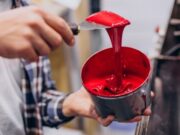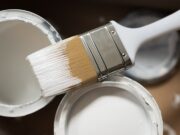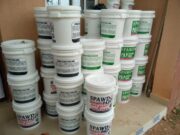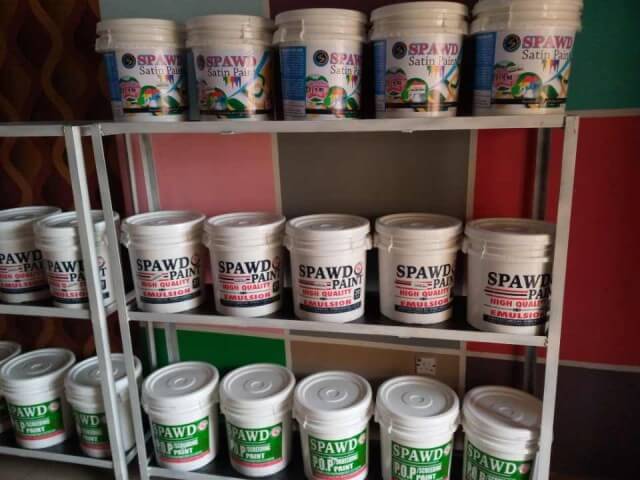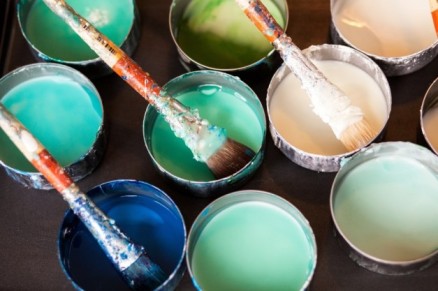Paint manufacturing is a sophisticated process that involves combining a variety of chemical compounds to create a product that is not only visually appealing but also durable and functional.
Each paint chemicals plays a specific role, contributing to its application properties, finish, durability, and even environmental impact.
In this article, we’ll walk you through the essential paint chemicals used in the manufacturing process, while examining their functions, uses, and importance in the industry.
1. Binders Also Known As Resins
Binders are among the most critical components in paint production.
These chemicals form the film that binds pigment particles together after the paint dries, providing adhesion, flexibility, and resistance to external factors.
Types of Binders and Their Importance
1. Acrylic Resins
These are common in water-based paints due to their excellent adhesion, durability, and resistance to UV light.
Acrylic binders are used in both interior and exterior paint manufacturing.
2. Alkyd Resins
These are oil-based binders providing high gloss and durability, making them ideal for furniture, metal, and wood surfaces.
Alkyd paints are known for their toughness and are often used in high-traffic areas.
3. Epoxy Resins
Known for exceptional chemical and abrasion resistance, epoxy resins are primarily used in industrial and protective coatings.
4. Polyurethane Resins
These offer excellent durability, abrasion resistance, and weather resistance, making them popular for both wood finishes and industrial applications.
2. Pigments Also Known as Colorants
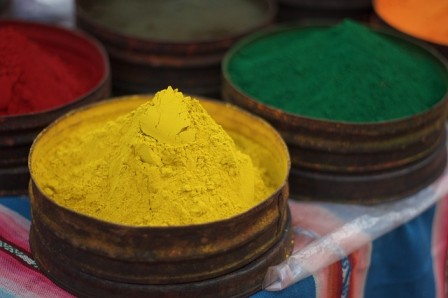
Pigments are finely ground, insoluble powders that give paint its color, opacity, and durability.
They can be classified into two main categories: primary pigments and extender pigments.
Types of Pigments and Their Importance
1. Primary Pigments
These pigments provide the paint’s primary color.
For example, titanium dioxide (TiO₂) is a common white pigment that offers high opacity and brightness.
2. Color Pigments
These include organic and inorganic compounds, such as iron oxide for reds and yellows, ultramarine for blue, and chromium oxide for green.
3. Extender Pigments
Extender pigments are inert fillers like calcium carbonate, silica, and talc.
They reduce the cost of paint production by extending the volume without affecting the color and also provide texture and durability to the paint film.
3. Solvents
Solvents are the liquid carriers that dissolve the other components, allowing your paint to be applied smoothly.
Once applied, the solvent evaporates, leaving the paint film on the surface.
Solvents can be classified as water-based (for waterborne paints) or organic solvents (for oil-based paints).
Types of Solvents and Their Importance
1. Water
Used in water-based paints (latex), water is an eco-friendly solvent with low toxicity and odor, making it ideal for interior applications.
2. Mineral Spirits
These are commonly used in alkyd or oil-based paints, mineral spirits allow for smooth application and a long-lasting finish.
3. Xylene and Toluene
These are powerful organic solvents used for fast-drying paints.
They are often employed in industrial and automotive coatings.
4. Ethylene Glycol
Used to control paint viscosity and prevent quick drying, ethylene glycol is valuable in maintaining a smooth finish, especially in water-based paints.
4. Additives
Additives are compounds used in small quantities to enhance specific properties of the paint.
These chemicals improve paint’s stability, texture, drying time, and resistance to external factors.
Types of Additives and Their Importance
1. Thickeners
Compounds like hydroxyethyl cellulose (HEC) and acrylic thickeners increase the paint’s viscosity, making it easier to apply.
2. Anti-Foaming Agents
Agents such as silicone-based compounds prevent foam formation during mixing, also ensuring a smooth application.
3. Biocides and Fungicides
These additives prevent the growth of mold, bacteria, and fungi, extending the life of your paint films, especially in humid environments.
4. UV (Ultra-Violet) Stabilizers
Compounds like benzophenone prevent fading by absorbing UV radiation, thus protecting exterior paints from sunlight degradation.
5. Drying Agents (Driers)
Metals such as cobalt, manganese, and zirconium speed up the drying process of alkyd paints, allowing for faster application cycles.
5. Plasticizers
Plasticizers are additives that enhance the flexibility and durability of the paint film.
They prevent cracking and flaking, particularly in exterior paints exposed to temperature fluctuations.
Importance of Plasticizers
Plasticizers like dibutyl phthalate and dioctyl phthalate improve the workability of paint, making it easier to spread and apply.
In industrial coatings, plasticizers help maintain structural integrity by enabling the paint to expand and contract with changes in temperature, thereby extending its lifespan.
6. Catalysts
Catalysts are chemicals that accelerate the curing or drying process, allowing for faster production and application.
They are particularly useful in two-component paint systems, such as epoxies and polyurethanes, which require a chemical reaction to harden.
Types of Catalysts and Their Importance
1. Amine Catalysts
Used in epoxy and polyurethane coatings, these catalysts help initiate and control the hardening process, resulting in a durable finish.
2. Metallic Catalysts
Cobalt, manganese, and zirconium compounds are used in alkyd paints to speed up drying by promoting oxidation of the binder.
7. Surfactants
Surfactants are essential for stabilizing the dispersion of pigments in the paint, preventing particles from clumping together.
They also enhance the paint’s spreadability and adhesion properties.
Types of Surfactants and Their Importance
1. Anionic Surfactants
These reduce the surface tension, improving the paint’s adhesion and ensuring a uniform coating on the surface.
2. Nonionic Surfactants
Known for their stability in various pH conditions, these surfactants enhance your paint’s viscosity, making it easier for you to apply.
8. Defoamers
Defoamers are also critical paint chemicals used in the prevention and formation of foam during the mixing and application of paint.
Foam can cause imperfections in your paint film, thereby reducing its smoothness and appearance.
Importance of Defoamers
Defoamers are typically made from mineral oils, silicone compounds, or fatty alcohols.
They eliminate air bubbles and ensure you have an even, flawless finish.
In high-quality paints, defoamers are essential for achieving a smooth and professional look on your walls and surfaces.
9. pH Adjusters
pH adjusters maintain your paint’s stability and shelf life by balancing the paint’s acidity or alkalinity.
A stable pH is crucial for preventing reactions that could degrade your paint’s components over time.
Types of pH Adjusters and Their Importance
1. Ammonia
Often used in water-based paints, ammonia stabilizes pH levels, ensuring proper dispersion of pigments and other components.
2. Alkanol amines
These compounds adjust pH while also acting as a stabilizer for other additives, ensuring your paint remains uniform and effective.
10. Rheology Modifiers
Rheology modifiers influence your paint’s flow and leveling characteristics, ensuring the paint spreads evenly and maintains a consistent thickness.
Importance of Rheology Modifiers
Compounds such as hydrophobically modified ethoxylated urethanes (HEUR) and clay-based thickeners are widely used in paints.
They enable the paint to have a balanced viscosity, allowing it to be applied smoothly without dripping, especially on vertical surfaces.
Environmental and Safety Considerations in Paint Production
In recent years, there has been a significant shift in the paint industry toward environmentally friendly and low-VOC (volatile organic compounds) formulations.
Many traditional solvents, pigments, and additives have been replaced or reformulated to reduce their environmental impact.
Water-based paints, for instance, have become popular due to their low toxicity and minimal environmental footprint.
1. Low-VOC Paints
VOCs are harmful chemicals that can cause air pollution and health issues.
Low-VOC or zero-VOC paints use safer alternatives for solvents and additives, making them suitable for indoor applications where air quality is a priority.
2. Green Certifications
Paint manufacturers increasingly seek certifications such as Green Seal and LEED (Leadership in Energy and Environmental Design) to assure consumers of their product’s eco-friendliness.
Conclusion
The production of paint is a complex process that combines chemistry and artistry to create a product that meets aesthetic and functional requirements.
Each paint chemical in the paint plays a vital role, from pigments that provide color to binders that ensure durability, solvents that facilitate application, and additives that enhance performance.
Understanding the role of these chemicals helps paint manufacturers like us to design products that cater to diverse applications, ensuring high-quality, and long-lasting finishes.
As the industry continues to innovate, the trend toward sustainable and eco-friendly paint formulations will likely shape the future of paint production, balancing performance with environmental responsibility.








